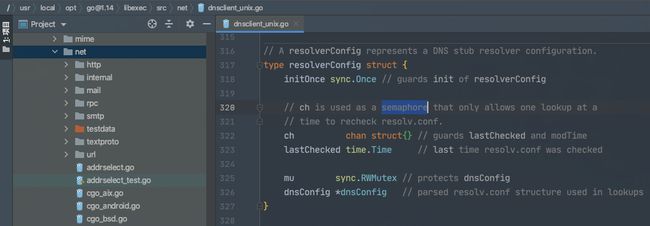初入门径
Java中有Semaphore类,用来限制访问特定资源的并发线程的数量.相对于内置锁synchronized和重入锁ReentrantLock的互斥性来说,Semaphore可以允许多个线程同时访问共享资源
信号量的概念由 Dijkstra 提出,广泛应用在不同的操作系统中。系统会给每一个进程一个信号量,代表每个进程当前的状态,未得到控制权的进程,会在特定的地方被迫停下来,等待可以继续进行的信号到来。
一般用信号量来保护一组资源, 如数据库连接池、一组客户端的连接等等。每次获取资源时,都会将信号量中的计数器减去对应的数值,在释放资源时重新加回来。当遇到信号量资源不够时,尝试获取的线程就会进入休眠,等待其他线程释放归还信号量。如果信号量是只有0和1的二进位信号量,那么其P/V就和互斥锁的Lock/Unlock一样了。
Go 内部使用信号量来控制goroutine的阻塞和唤醒,如互斥锁sync.Mutex结构体的第二个字段,就是一个信号量:
type Mutex struct {
state int32
sema uint32
}信号量的PV操作在Go内部是通过下面这几个底层函数实现的. 这几个函数都仅供Go语言内部调用,不能在编程时直接使用。
func runtime_Semacquire(s *uint32)
func runtime_SemacquireMutex(s *uint32, lifo bool, skipframes int)
func runtime_Semrelease(s *uint32, handoff bool, skipframes int)更多可参考 sync包-Mutex
不过Go的 扩展并发原语包 中提供了带权重的信号量 semaphore.Weighted
使用场景
在实际开发中,当需要控制访问资源的线程数量时,就会需要信号量.
假设有一组要抓取的网站, 资源有限,最多允许同时执行三个抓取任务. 当同时有三个抓取任务在执行时,在执行完一个抓取任务后才能执行下一个排队等待的任务.
这个问题用Channel也能解决,在此使用Go提供的信号量原语来解决该问题:
package main
import (
"context"
"fmt"
"sync"
"time"
"golang.org/x/sync/semaphore"
)
func doSomething(u string) { // 模拟抓取任务的执行
fmt.Printf("开始抓取%s网站\n", u)
time.Sleep(5 * time.Second)
}
const (
Limit = 3 // 同時并行运行的goroutine上限
Weight = 1 // 每个goroutine获取信号量资源的权重
)
func main() {
urls := []string{
"http://www.apple.com",
"http://www.baidu.net",
"http://www.c.com",
"http://www.d.com",
"http://www.ebay.com",
}
s := semaphore.NewWeighted(Limit)
var w sync.WaitGroup
for _, u := range urls {
//for的速度远远快过起协程,所以到这里并往下执行时,可能是5个字符串元素时间差不多
w.Add(1)
go func(u string) {
s.Acquire(context.Background(), Weight)
doSomething(u)
s.Release(Weight)
w.Done()
}(u)
}
w.Wait()
fmt.Println("All Done")
}输出为:
开始抓取http://www.ebay.com网站
开始抓取http://www.c.com网站
开始抓取http://www.apple.com网站
(等待5s后)
开始抓取http://www.baidu.net网站
开始抓取http://www.d.com网站
All Done源码实现
源码行数不多,加上注释一共136行.
// Copyright 2017 The Go Authors. All rights reserved.
// Use of this source code is governed by a BSD-style
// license that can be found in the LICENSE file.
// Package semaphore provides a weighted semaphore implementation.
package semaphore // import "golang.org/x/sync/semaphore"
import (
"container/list"
"context"
"sync"
)
// 如果调用者请求不到信号量的资源就会被加入等待者列表里
type waiter struct {
n int64 // 调用者请求的资源数
// ready通道会在调用者可以被重新唤醒的时候被close掉,从而起到通知正在阻塞读取ready通道的等待者的作用
ready chan<- struct{} // Closed when semaphore acquired. // 当调用者可以获取到信号量资源时, close这个chan
}
// NewWeighted creates a new weighted semaphore with the given
// maximum combined weight for concurrent access.
func NewWeighted(n int64) *Weighted {
w := &Weighted{size: n}
return w
}
// Weighted provides a way to bound concurrent access to a resource.
// The callers can request access with a given weight.
type Weighted struct {
size int64 // 字段用来记录信号量拥有的最大资源数
cur int64 // 标识当前已被使用的资源数
mu sync.Mutex // 互斥锁,用来提供对其他字段的临界区保护
waiters list.List // 表示申请资源时由于可使用资源不够而陷入阻塞等待的调用者列表
}
// Acquire acquires the semaphore with a weight of n, blocking until resources
// are available or ctx is done. On success, returns nil. On failure, returns
// ctx.Err() and leaves the semaphore unchanged.
//
// If ctx is already done, Acquire may still succeed without blocking.
// Acquire方法会监控资源是否可用,且还会检测传递进来的context.Context对象是否发送了超时过期或者取消的信号
func (s *Weighted) Acquire(ctx context.Context, n int64) error {
s.mu.Lock()
// 如果恰好有足够的资源,也没有排队等待获取资源的goroutine,则将cur加上n后直接返回
if s.size-s.cur >= n && s.waiters.Len() == 0 {
s.cur += n
s.mu.Unlock()
return nil
}
// 请求的资源数 > 能提供的最大资源数, 则该任务处理不了,走错误处理逻辑
if n > s.size {
// Don't make other Acquire calls block on one that's doomed to fail.
s.mu.Unlock()
// 依赖ctx的状态返回,否则一直等待
<-ctx.Done()
return ctx.Err()
}
// 现存资源不够, 需要把调用者加入到等待队列中
// 创建了一个ready chan,以便被通知唤醒
ready := make(chan struct{})
//如果调用者请求不到信号量的资源就会被加入等待者列表里
w := waiter{n: n, ready: ready}
elem := s.waiters.PushBack(w)
s.mu.Unlock()
// 等待
select {
case <-ctx.Done(): // context的Done被关闭
err := ctx.Err()
s.mu.Lock()
select {
case <-ready: // 如果被唤醒了,则忽略ctx的状态
// Acquired the semaphore after we were canceled. Rather than trying to
// fix up the queue, just pretend we didn't notice the cancelation.
err = nil
default: // 通知waiter
isFront := s.waiters.Front() == elem
s.waiters.Remove(elem)
// If we're at the front and there're extra tokens left, notify other waiters.
// 通知其它的waiters,检查是否有足够的资源
if isFront && s.size > s.cur {
s.notifyWaiters()
}
}
s.mu.Unlock()
return err
case <-ready: // 等待者被唤醒
return nil
}
}
// TryAcquire acquires the semaphore with a weight of n without blocking.
// On success, returns true. On failure, returns false and leaves the semaphore unchanged.
func (s *Weighted) TryAcquire(n int64) bool {
s.mu.Lock()
success := s.size-s.cur >= n && s.waiters.Len() == 0
if success {
s.cur += n
}
s.mu.Unlock()
return success
}
// Release releases the semaphore with a weight of n.
//Release方法很简单, 它将当前计数值减去释放的资源数 n, 并调用notifyWaiters方法,尝试唤醒等待队列中的调用者,看是否有足够的资源被获取
func (s *Weighted) Release(n int64) {
s.mu.Lock()
s.cur -= n
if s.cur < 0 {
s.mu.Unlock()
panic("semaphore: released more than held")
}
s.notifyWaiters()
s.mu.Unlock()
}
// notifyWaiters方法 会逐个检查队列里等待的调用者,如果现存资源 够等待者请求的数量n,或者是没有等待者了,就返回
func (s *Weighted) notifyWaiters() {
for {
next := s.waiters.Front()
if next == nil {
break // No more waiters blocked. // 没有等待者了,直接返回
}
w := next.Value.(waiter)
if s.size-s.cur < w.n {
// 如果现有资源不够队列头调用者请求的资源数,就退出所有等待者会继续等待
// 这里还是按照先入先出的方式处理是为了避免饥饿
// Not enough tokens for the next waiter. We could keep going (to try to
// find a waiter with a smaller request), but under load that could cause
// starvation for large requests; instead, we leave all remaining waiters
// blocked.
//
// Consider a semaphore used as a read-write lock, with N tokens, N
// readers, and one writer. Each reader can Acquire(1) to obtain a read
// lock. The writer can Acquire(N) to obtain a write lock, excluding all
// of the readers. If we allow the readers to jump ahead in the queue,
// the writer will starve — there is always one token available for every
// reader.
break
}
s.cur += w.n
s.waiters.Remove(next)
close(w.ready)
}
}
// notifyWaiters方法 是按照先入先出的方式唤醒调用者。当释放 100 个资源时,如果第一个等待者需要 101 个资源,那么,队列中的所有等待者都会继续等待,即使队列后面有的等待者只需要 1 个资源。这样做的目的是避免饥饿,否则的话,资源可能总是被那些请求资源数小的调用者获取,这样一来,请求资源数巨大的调用者,就没有机会获得资源了。
注意事项
Go语言中使用到信号量的场景,一般会被channel所取代,因为一个buffered chan(带缓冲的channel)也可以代表 n 个资源.semaphore.Weight其实实际使用得不多,但如果用到需要注意:
Acquire和TryAcquire方法都可以用于获取资源,前者会阻塞的获取信号量,后者会非阻塞的获取信号量,如果获取不到就返回falseRelease归还信号量后,会以先进先出的顺序唤醒等待队列中的调用者.如果现有资源不够处于等待队列前面的调用者请求的资源数,所有等待者会继续等待。- 如果一个goroutine申请较多的资源,由于上面说的归还后唤醒等待者的策略,它可能会等待比较长的时间。
官方库或知名项目中的使用
在docker项目中有使用:

而在大多数项目中,都用channel来替代semaphore.Weight作为信号量,
如Go的官方库net:
如golang.org/x/net/netutil/listen.go:
如go/pkg/mod/gopkg.in/gographics/[email protected]/imagick/magick_wand_env.go:
这里有另一种实现
本文由mdnice多平台发布


